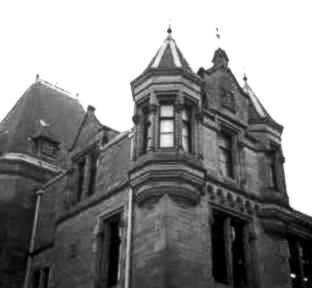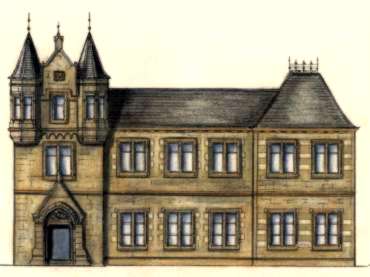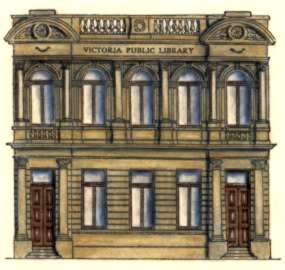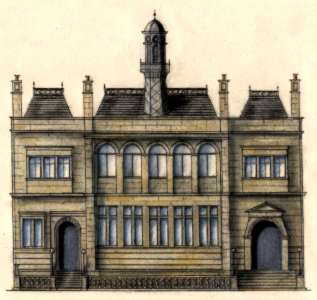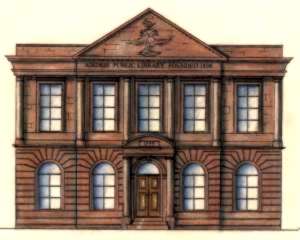The Central Library in Dunfermline (left) was the world's first Carnegie Library, opening in August 1883.
In 1879 Andrew Carnegie had offered his native town £5000 to build a library. This library’s success must have been a factor when he decided to finance a worldwide programme of almost 3000 public libraries throughout the English speaking world.
In 1904 the management of the library was taken over by the Carnegie Dunfermline Trust , who completed an extension to the original building before transferring control back to the Town Council in 1922.
The Trust continued, however, to contribute £400 per annum to the library until 1958, when the Council assumed the full cost of the service, including the latest library extension in 1993.
Central Library, Dunfermline.
Opened 25th August, 1883
The architect of the Dunfermline library, James Campbell Walker of Edinburgh, combined a mixture of disconnected styles to somehow produce a design that works as a whole.
The library has a Gothic entrance which contains a carved sun with Carnegie’s "Let there be light" motto in the banner below. In contrast to the doorway, the building is crowned with corbelled turrets more reminiscent of a French château. The remainder of the frontage is less elaborate with regular evenly spaced windows.

Mrs Margaret Carnegie, Andrew's mother, laid the library's memorial stone, on 27th July 1881 when they returned to the town they had left 33 years earlier.
There is a marble bust of the old lady (right) in the entrance hall of the library.
On 25th August 1883, two years after the Carnegies' visit to Dunfermline, the library was officially opened by Lord Rosebery, who would later become British Prime Minister.
Victoria Library, Grangemouth.
Opened 31st January, 1889
This was Scotland's second Carnegie library, completed just two months before America's first Carnegie library opened in Braddock, Pennsylvania on 30th March 1889.
The competition to design the building took place in 1888, following a visit to the town by the newly married Mr and Mrs Carnegie in the summer of 1887. Mrs Carnegie informed the town council that her husband would provide the finance for the library, as he had done a few years earlier in nearby Dunfermline.
The library's title came from Queen Victoria's Golden Jubilee, which had occurred on 20th June 1887, around the time of the Carnegies' honeymoon visit to Scotland.
The library is housed in a two storey neo-classical building designed by Andrew Black of Falkirk. It is constructed with locally quarried cream sandstone. Corinthian columns flank the arched windows over the doorways, and the composition is topped with a fine stone balustrade.
It was designed in a universally popular style, which would readily fit in with the municipal buildings erected in the great cities on either side of Atlantic in the same era.
The library was opened on 31st January 1889 by Mr. T.D. Brodie Its current use remains as a branch library, with the upper floor as a museum.
Central Library, Edinburgh.
Opened 9th June, 1890
The magnificent Central Library on George IV Bridge is the only Carnegie library built in Scotland's capital, although the 1904 Corstorphine library was subsequently taken into the city's system in 1920.
This is in total contrast to Glasgow, where Andrew Carnegie funded the system of branch libraries, but not the principal reference library.
Edinburgh's earliest branch libraries were provided by the publisher, Thomas Nelson, and built in conjunction with the network of local "Nelson Halls".
In 1864 the citizens of Edinburgh had rejected a proposal to adopt the Libraries Act by 1106 votes to 71 as it would have caused extra taxation.
Opinions were to change however after Carnegie wrote to the Lord Provost, Sir Thomas Clark, on 27th April 1886 offering £25,000 to build a central library for the city. To make the adoption of the Act practically certain he cabled an amendment to this letter few days later, increasing this sum to £50,000. The public meeting which followed approved the adoption of the Act almost unanimously, with only 4 objections.
While touring Scotland on honeymoon with his new wife, Louise, during the following summer, he found time to lay the memorial foundation stone, on 9th July 1887.
.His interest continued up to the opening ceremony in 1890, when he sent a telegraph to be read to the assembled crowd. The message read "We trust that this library is to grow in usefulness year after year and prove one of the most potent agencies for the good of the people for all time to come."
The library building was designed by the renowned architect, George Washington Browne. It is built in the French Renaissance style with much elaborate decoration, as the architect was very indulgent with his large budget. The front elevation, with the entrance on George IV Bridge is deceptive, as there are actually 4 storeys below the bridge, with the library standing in the gorge below. The elevations below the bridge are completely unadorned. The library was officially opened by Lord Rosebery on 9th June 1890, and opened to the public one week later.
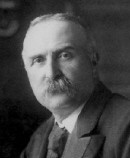
Carnegie formed a personal friendship with Edinburgh's first City Librarian, Hew Morrison, who brought his attention to the estate at Skibo, were he would later spend his retirement.
Morrison (right) represented Carnegie at many opening ceremonies throughout Scotland and was entrusted with many of the day-today decisions regarding the library programme. He dealt with much of the correspondence from the local councils who were seeking to have a Carnegie Library for their community.
Aberdeen Library
Opened 5th July, 1892
The funds for the Aberdeen Public Library were raised by a public appeal which had started in 1889. Andrew Carnegie was invited to perform the opening ceremony after he and Mrs Carnegie had each contributed £1000 towards the construction costs. At the luncheon following the opening ceremony he offered to contribute a further £1000 to clear the debt for the £10,000 library.
The successful architect in the open competition was Alexander Brown, who also designed the bookcases, counters and other fittings for the library. It was built with granite in the regular symmetrical Renaissance style that was to become very popular for the Carnegie Libraries of the new century. Brown was also responsible for the extension to create the Central Reading Room in 1905.
In the morning of 5th July 1892, prior to the opening ceremony, Carnegie had been presented with the freedom of the city by Lord Provost Stewart and given a ceremonial burgess ticket, which was tied with a crimson ribbon to his top hat.
They then rode through the city in open carriages accompanied by marching bands, along a route decorated by floral tributes. They were cheered on by large crowds who had turned out in the brilliant sunshine to witness the scenes.
Meanwhile, back in the United States, serious industrial unrest had broken out after the staff at Carnegie Steel's Homestead plant, near Pittsburgh, were issued with new contracts and denied the right to belong to a trade union. This led to a workforce blockade of the works in early July, while Carnegie was far away in Scotland.
On 5th July, as Carnegie was being feted by the people of Aberdeen, moves were being made in Pittsburgh to bring an end to the Homestead blockade by hiring 300 Pinkerton agents to take over the plant. A prolonged battle took place the following morning, 6th July, after Pinkerton's men had shot dead two of the protesting workers. This resulted in even more fatalities and some of the agents were beaten to death.
The universal condemnation which followed was viewed from afar by Carnegie, who did not venture back to the U.S. until 1893, by which time the men had returned to work on much reduced wages and longer hours.
His resultant lack of popularity, both here and in America, over the Homestead dispute probably had some bearing on his later philanthropy and desire for adulation.
Airdrie Library
Opened August, 1893
In November 1853, Airdrie adopted the Free Libraries Act, some 13 years before any other Scottish burgh. When visiting the town in 1906, Andrew Carnegie congratulated Provost Knox and the people of Airdrie, reminding them that "Airdrie was the first town in Scotland to adopt the Free Libraries Act of 1853 - an honour of which Airdrie can never be robbed. "
Airdrie's public library was originally housed in the Town Hall, and then the Market Buildings, before moving in 1893 to a new two-storey building in Anderson Street, designed by George Arthur. The library was partially financed by Andrew Carnegie who contributed £1500 towards its construction.
The symmetrical neo-classical frontage in red sandstone has a rusticated ground floor and a central pediment supported by Ionic columns.
The 1893 building only served as a library for 32 years, when it was replaced by a new library funded by the Carnegie UK Trust in September 1925.
Its current use is as an Arts Centre.
1893 was also the year the first ever Carnegie Library was built outside Scotland or Pennsylvania, when the new library at Fairfield, Iowa opened in November. Carnegie had returned to America in the spring of 1893, after the clamour had died down following the Homestead debacle. Thereafter Carnegie libraries started appearing in places with no personal associations with Andrew Carnegie.
Dundee was one of the first places in Scotland to provide its citizens with a free library, when in 1869 the Dundee Free Public Library opened within the city's Albert Memorial Institute which had been designed by George Gilbert Scott.

Prior to establishing its Carnegie libraries Dundee had a two-tier system of borrowers. New books were reserved for middle class subscribers who paid an annual subscription, while working class readers who could not afford the fees had to wait a year for the books to become available.
The demand for books was so great among the general population of Dundee that the Council was keen to provide more libraries. The branch library at Lochee was built in 1895 financed by a legacy from the late Thomas. H. Cox.
In 1901, Dundee Town Council approached Andrew Carnegie's advisors, Hew Morrison in Edinburgh and John Ross in Dunfermline, about funding libraries throughout the city. After examining the proposals, Carnegie promised £37,000 for the building of a further five branch libraries for the city.
Carnegie Libraries of Scotland: Architecture & History

 Introduction
Introduction
The Carnegie Libraries
 Andrew Carnegie
Andrew Carnegie
His Scottish connections
 Early Carnegie Libraries
Early Carnegie Libraries
The first in the world
 American Libraries
American Libraries
A comparative study
 Scottish Architecture
Scottish Architecture
Unique libraries
 Renaissance
Renaissance
Edwardian architecture
 Baroque
Baroque
J.R. Rhind in Glasgow
 Library Architecture
Library Architecture
Diverse designs
 Inside the Libraries
Inside the Libraries
Photographs from 1907
 Carnegie Hero
Carnegie Hero
John Blaikie in 1911
 Exhibition
Exhibition
Landmarks of Literacy
